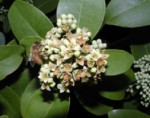Scientific Name: Santalum ellipticum
Also Known As: Sandalwood
Endemic
Description: Large bushy shrubs or trees up to 15 feet tall, but usually 4 to 8 feet tall, with elliptical, pale, green-blue leaves and fragrant flower clusters that are light green with hints of salmon or orange. Once pollinated, the flowers develop into round fruits that ripen to a dark purple and have a single hard seed within. The most appealing feature is its sweet-smelling heartwood, which retains the sandalwood fragrance for a long time.
Distribution: Four species of sandalwood are endemic to Hawaii, with even more subspecies. This particular species is found on all the main islands, mostly in low coastal regions, although it no longer grows on Kahoolawe. One natural plant on the Big Island does grow at above 6,000 feet.
Cultural Uses: The sweet-smelling wood of ‘iliahi is used to scent kapa, and the flower clusters can be used in leis.
Extra Info: Sandalwood was one of Hawaii’s first exports. Trading was founded in 1791 by Capt. John Kendrick of Boston and lasted until about 1840, when the sandalwood was pretty much wiped out. It is estimated that ‘iliahi sold for about $125 per ton and that the industry made close to $4 million.
Hawaiians were forced into labor, so the clearing of ‘iliahi not only hurt the population of the plant, but also the morale of the people. There is even documentation of the labor being so brutal that family members would actually pull out young sandalwood plants so that their loved ones wouldn’t have to do it in the future.
Iliahi a loe
